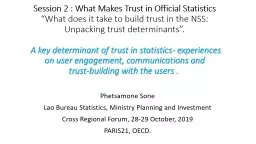

What does it take to build trust in the NSS Unpacking trust determinants A key determinant of trust in statistics experiences on user engagement communications and trustbuilding with the users ID: 804927
Download The PPT/PDF document "Session 2 : What Makes Trust in Official..." is the property of its rightful owner. Permission is granted to download and print the materials on this web site for personal, non-commercial use only, and to display it on your personal computer provided you do not modify the materials and that you retain all copyright notices contained in the materials. By downloading content from our website, you accept the terms of this agreement.
Slide1
Session 2 : What Makes Trust in Official Statistics“What does it take to build trust in the NSS: Unpacking trust determinants”. A key determinant of trust in statistics- experiences on user engagement, communications and trust-building with the users .
Phetsamone
Sone
Lao Bureau Statistics, Ministry Planning and Investment
Cross
Regional
Forum, 28-29
October,
2019
PARIS21,
OECD.
Slide2“What does it take to build trust in the NSS: Unpacking trust determinants”.
Slide3Users engagement, communications and trust-building with
users
- NSS, LAOPDR
Lao’s
Statistics Law was adopted in 2010 and was revised in 2017. The Statistics Law includes provisions relating to increasing credibility and gaining the trust of statistics users, as well as enhancing the relationship between statistical users and producers. The SDNSS 2016-2025 and Vision 2030 aims to improve and strengthen the foundation for statistical production, ensure that NSS is comparable to international standards, and build the credibility of the NSS. Work Program 3- includes activities for the creation of an efficient coordination system which allows statistics producers, users and relevant stakeholders to cooperate, exchange information, connect and network, as well establishing a mechanism that allows producers and users to regularly meet and work together. The 8th Five-Year National Socio-Economic Development Plan (2016-2020) is outcomes-based and recognizes the importance of national statistics to provide the evidence base for decision making and monitoring and evaluation of progress. The Government of Laos, with its partners, has aligned its 8th national development plan and M&E framework with the goals, targets and indicators of the SDGs and will continue with the 9th NSEDP 2021-2025. The Plan is complemented by a monitoring and evaluation (M&E) framework to keep track of implementation progress and which provides a reference for all stakeholders to support, monitor and evaluate progress in different domainsStatistical Indicators framework and list of indicators defined ( NSEDP, SDGIs( localized ), LDCs…..)
2. Identified Users and Uses of Statistics
UserUsesData Formats Government leadershipPolicy and decision making, planning, budget allocation. (7th NSEDP and MDGs reports , 8th NSEDP and 9th NSEDP formulation , the SDGs ‘ VNR report and mid-term review and final assessment of for the NSEDP, LDCs studies and report 2018 ….)Headline indicators, ready-made analyses, summary documentsGovernment line ministries Inform policies, development planning, monitoring and evaluation, regulationRaw data, metadata, indicators, electronic and reusable formats, statistical yearbooksBusiness and private sector, banking sectorMarket research, investment decisionsIn-depth reports, sectoral reports, summary figuresDevelopment partners , international organizations (ADB, WB, IMF, UN agencies )International and regional comparisons, rankingsIndicators, raw data, monitoring reportsColleges, institutes, universities, private research institutes, researchers, studentsResearch and analysis, project proposals, theses, curriculum developmentRaw data, metadata, indicators, reusable and machine-readable formats, explanatory text in accessible formats
1. Legislation, policy and the
d
emand
driven statistics
Slide4Users engagement, communications and trust-building with users3. Progress
4. The way forward
Undertaken activities to strengthen user engagement:
+ annual national statistics day forum,
+ user and producer meetings, + regular publications and data pamphlets, + developing the LSB website+ user satisfaction surveys+ E-GDDS ( National Data Summery Page (NDSP))- Metadata and SDMX…. +Lao PDR 2030 Agenda Communications (National SDGs Secretariat, December 2018) + Master Plan on the Dissemination of Statistics produced and users engagement training conducted .Results: increase the efficiency in the system , gradually increase capacity in producing statistics – right indicators increase data uses ….( partially achieved ) Challenges : + Limitation of HR (included the communication skill)
+ Financial resources, statistical infrastructures… ;
+ Data quality issues ( inconsistencies from # sources, shortcoming with statistics, lack of good metadata, some time data not well presented…) User engagement strategy ( sets out the path towards the institutionalization of user-producer relationships in a systematic way ( being finalized )Prepare the implementation plan to meet the objectives set out in the strategy – working in progress (strengthen data dissemination and ensuring data security; Enhance mechanisms for sharing data, a common user-friendly statistical database and portal to be developed; Build awareness and engagement include statistical literacy; ensure feedback mechanisms to facilitate input from users and assess the use of statistical data).User engagement principles ( responsive , relevant, accessible, modern, harmonize, reliable and targeted Mean of engagement ( Pre-Production, Stage Production and Stage Post-Production Dissemination Stage Implement the Production and Dissemination plan – set out plan release calendar Capacity building in the areas of production , communication, dissemination and public-relation